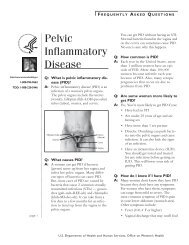Human Papillomavirus (HPV) and Genital Warts - WomensHealth.gov
Human Papillomavirus (HPV) and Genital Warts - WomensHealth.gov
Human Papillomavirus (HPV) and Genital Warts - WomensHealth.gov
You also want an ePaper? Increase the reach of your titles
YUMPU automatically turns print PDFs into web optimized ePapers that Google loves.
F r e q u e n t l y As k e d Qu e s t i o n s<br />
http://www.womenshealth.<strong>gov</strong><br />
1-800-994-9662<br />
TDD: 1-888-220-5446<br />
page 1<br />
<strong>Human</strong><br />
<strong>Papillomavirus</strong><br />
(<strong>HPV</strong>) <strong>and</strong><br />
<strong>Genital</strong> <strong>Warts</strong><br />
Q: What is human papillomavirus<br />
(<strong>HPV</strong>)?<br />
A: <strong>Human</strong> papillomavirus (pap-uh-LOHmuh-veye-ruhss),<br />
or <strong>HPV</strong>, is the name<br />
for a group of viruses that includes<br />
more than 100 types. More than 40<br />
types of <strong>HPV</strong> can be passed through<br />
sexual contact.<br />
The types of <strong>HPV</strong> that infect the genital<br />
area are called genital <strong>HPV</strong>. Over<br />
half of sexually active people will have<br />
<strong>HPV</strong> at some point in their lives. But<br />
most people never know it. This is<br />
because <strong>HPV</strong> most often has no symptoms<br />
<strong>and</strong> goes away on its own.<br />
Q: How many people have <strong>HPV</strong>?<br />
A: <strong>Genital</strong> <strong>HPV</strong> is the most common<br />
sexually transmitted infection (STI) in<br />
the United States. About 20 million<br />
Americans ages 15 to 49 currently have<br />
<strong>HPV</strong>. And at least half of all sexually<br />
active men <strong>and</strong> women get genital <strong>HPV</strong><br />
at some time in their lives.<br />
Q: What is the difference between<br />
the high-risk <strong>and</strong> low-risk types<br />
of <strong>HPV</strong>?<br />
A: Some types of <strong>HPV</strong> can cause cervical<br />
cancer. These types of <strong>HPV</strong> are called<br />
high-risk. Having high-risk <strong>HPV</strong> is<br />
not the same as having cervical cancer.<br />
But high-risk <strong>HPV</strong> can lead to cancer.<br />
Most often, high-risk <strong>HPV</strong> causes no<br />
health problems <strong>and</strong> goes away on its<br />
own. High-risk <strong>HPV</strong> cases that don’t<br />
go away are the biggest risk factor for<br />
cervical cancer. If you have high-risk<br />
<strong>HPV</strong>, your doctor can look for changes<br />
on your cervix during Pap tests.<br />
Changes can be treated to try to prevent<br />
cervical cancer. Be sure to have regular<br />
Pap tests so changes can be found early.<br />
Low-risk <strong>HPV</strong> can cause genital<br />
warts. <strong>Warts</strong> can form weeks, months,<br />
or years after sexual contact with an<br />
infected person. In women genital<br />
warts can grow:<br />
• Inside <strong>and</strong> around the outside of the<br />
vagina<br />
• On the vulva ("lips" or opening to<br />
the vagina), cervix, or groin<br />
• In or around the anus<br />
In men, genital warts can grow:<br />
• On the penis<br />
• On the scrotum, thigh, or groin<br />
• In or around the anus<br />
Rarely, genital warts grow in the<br />
mouth or throat of a person who had<br />
oral sex with an infected person.<br />
The size of genital warts varies. Some<br />
are so small you can't see them. They<br />
can be flat <strong>and</strong> flesh-colored or look<br />
bumpy like cauliflower. They often<br />
form in clusters or groups. They may<br />
itch, burn, or cause discomfort.<br />
Low-risk <strong>HPV</strong> doesn’t always cause<br />
warts. In fact, most people with lowrisk<br />
<strong>HPV</strong> never know they are infected.<br />
This is because they don't get warts or<br />
any other symptoms.<br />
U.S. Department of Health <strong>and</strong> <strong>Human</strong> Services, Office on Women’s Health
F r e q u e n t l y As k e d Qu e s t i o n s<br />
http://www.womenshealth.<strong>gov</strong><br />
1-800-994-9662<br />
TDD: 1-888-220-5446<br />
page 2<br />
Q: How do women get <strong>HPV</strong>?<br />
A: <strong>Genital</strong> <strong>HPV</strong> is passed by skin-to-skin<br />
<strong>and</strong> genital contact. It is most often<br />
passed during vaginal <strong>and</strong> anal sex.<br />
Although much less common, it is possible<br />
to pass <strong>HPV</strong> during oral sex or<br />
h<strong>and</strong> to genital contact.<br />
Q: Should I get the <strong>HPV</strong> vaccine?<br />
A: It depends on your age <strong>and</strong> whether or<br />
not you already have had sex.<br />
Two vaccines (Cervarix <strong>and</strong> Gardasil)<br />
can protect girls <strong>and</strong> young women<br />
against the types of <strong>HPV</strong> that cause<br />
most cervical cancers. The vaccines<br />
work best when given before a person's<br />
first sexual contact, when she could<br />
be exposed to <strong>HPV</strong>. Both vaccines are<br />
recommended for 11 <strong>and</strong> 12 year-old<br />
girls. But the vaccines also can be used<br />
in girls as young as 9 <strong>and</strong> in women<br />
through age 26 who did not get any or<br />
all of the shots when they were younger.<br />
These vaccines are given in a series<br />
of 3 shots. It is best to use the same<br />
vaccine br<strong>and</strong> for all 3 doses. Ask your<br />
doctor which br<strong>and</strong> vaccine is best for<br />
you. The vaccine does not replace the<br />
need to wear condoms to lower your<br />
risk of getting other types of <strong>HPV</strong> <strong>and</strong><br />
other sexually transmitted infections.<br />
Women who have had the <strong>HPV</strong> vaccine<br />
still need to have regular Pap tests.<br />
Studies are also being done on <strong>HPV</strong><br />
vaccines for males.<br />
Q: How do I know if I have an <strong>HPV</strong><br />
infection?<br />
A: Most women who have <strong>HPV</strong> infections<br />
never know it. This is one reason why<br />
you need regular Pap tests. A Pap test is<br />
when a cell sample is taken from your<br />
cervix <strong>and</strong> looked at with a microscope.<br />
A Pap test can find changes on the cervix<br />
caused by <strong>HPV</strong>. To do a Pap test,<br />
your doctor will use a small brush to<br />
take cells from your cervix. It’s simple,<br />
fast, <strong>and</strong> the best way to find out if your<br />
cervix is healthy.<br />
If you are age 30 or older, your doctor<br />
may also do an <strong>HPV</strong> test with your<br />
Pap test. This is a DNA test that detects<br />
most of the high-risk types of <strong>HPV</strong>. It<br />
helps with cervical cancer screening. If<br />
you’re younger than 30 years old <strong>and</strong><br />
have had an abnormal Pap test result,<br />
your doctor may give you an <strong>HPV</strong> test.<br />
This test will show if <strong>HPV</strong> caused the<br />
abnormal cells on your cervix.<br />
One other way to tell if you have an<br />
<strong>HPV</strong> infection is if you have genital<br />
warts. (See What is the difference<br />
between the high-risk <strong>and</strong> low-risk<br />
types of <strong>HPV</strong>? for more details.)<br />
Q: Do I still need a Pap test if I got<br />
the <strong>HPV</strong> vaccine?<br />
A: Yes. There are three reasons why:<br />
1. The vaccine does not protect against<br />
all <strong>HPV</strong> types that cause cancer.<br />
2. Women who don’t get all the vaccine<br />
doses (or at the right time)<br />
might not be fully protected.<br />
3. Women may not fully benefit from<br />
the vaccine if they got it after getting<br />
one or more of the four <strong>HPV</strong> types.<br />
Q: How often should I get a Pap test?<br />
A: Follow these guidelines:<br />
• Have a Pap test every 2 years starting<br />
at age 21. Women 30 <strong>and</strong> older who<br />
have had three normal Pap tests in a<br />
row can now have one every 3 years.<br />
• If you are older than 65, you may be<br />
U.S. Department of Health <strong>and</strong> <strong>Human</strong> Services, Office on Women’s Health
F r e q u e n t l y As k e d Qu e s t i o n s<br />
http://www.womenshealth.<strong>gov</strong><br />
1-800-994-9662<br />
TDD: 1-888-220-5446<br />
able to stop having Pap tests. Discuss<br />
your needs with your doctor.<br />
• If you had your cervix taken out as<br />
part of a hysterectomy, you do not<br />
need further Pap tests if the surgery<br />
was not due to cancer.<br />
• Talk with your doctor or nurse<br />
about when to begin testing, how<br />
often you should be tested, <strong>and</strong><br />
when you can stop.<br />
Q: What happens if I have an<br />
abnormal Pap test?<br />
A: An abnormal result does not mean you<br />
have <strong>HPV</strong> or cervical cancer. Other<br />
reasons for an abnormal Pap test result<br />
include:<br />
• Yeast infections<br />
• Irritation<br />
• Hormone changes<br />
If your Pap test is abnormal, your doctor<br />
may do the test again. You may also<br />
have an <strong>HPV</strong> test or these tests:<br />
• Colposcopy. A device is used to<br />
look closely at your cervix. It lets the<br />
doctor look at any abnormal areas.<br />
• Schiller test. The test involves<br />
coating the cervix with an iodine<br />
solution. Healthy cells turn brown<br />
<strong>and</strong> abnormal cells turn white or<br />
yellow.<br />
• Biopsy. A small amount of cervical<br />
tissue is taken out <strong>and</strong> looked at<br />
under a microscope. This way the<br />
doctor can tell if the abnormal cells<br />
are cancer.<br />
Q: Could I have <strong>HPV</strong> even if my<br />
Pap test was normal?<br />
A: Yes. You can have <strong>HPV</strong> but still have<br />
a normal Pap test. Changes on your<br />
cervix may not show up right away;<br />
or they may never appear. For women<br />
older than 30 who get an <strong>HPV</strong> test <strong>and</strong><br />
a Pap test, a negative result on both the<br />
Pap <strong>and</strong> <strong>HPV</strong> tests means no cervical<br />
changes or <strong>HPV</strong> were found on the<br />
cervix. This means you have a very low<br />
chance of getting cervical cancer in the<br />
next few years.<br />
Q: Can <strong>HPV</strong> be cured?<br />
A: No. There is no cure for the virus <strong>HPV</strong>.<br />
But there are treatments for the changes<br />
<strong>HPV</strong> can cause on the cervix. <strong>Genital</strong><br />
warts can also be treated. Sometimes, the<br />
virus goes away on its own.<br />
Q: What treatments are used to<br />
get rid of abnormal cells on the<br />
cervix?<br />
A: If you have abnormal cells on the cervix,<br />
follow up with your doctor. If the<br />
problem is mild, your doctor may wait<br />
to see if the cells heal on their own. Or<br />
your doctor may suggest taking out the<br />
abnormal tissue. Treatment options<br />
include:<br />
• Cryosurgery, when abnormal tissue<br />
is frozen off.<br />
• Loop electrosurgical excision<br />
procedure (LEEP), where tissue is<br />
removed using a hot wire loop.<br />
• Laser treatment, which uses a<br />
beam of light to destroy abnormal<br />
tissue.<br />
page 3<br />
U.S. Department of Health <strong>and</strong> <strong>Human</strong> Services, Office on Women’s Health
F r e q u e n t l y As k e d Qu e s t i o n s<br />
http://www.womenshealth.<strong>gov</strong><br />
1-800-994-9662<br />
TDD: 1-888-220-5446<br />
page 4<br />
• Cone biopsy, where a coneshaped<br />
sample of abnormal tissue is<br />
removed from the cervix <strong>and</strong> looked<br />
at under the microscope for signs of<br />
cancer. This biopsy also can serve as<br />
a treatment if all the abnormal tissue<br />
is removed.<br />
After these treatments, you may have:<br />
• Vaginal bleeding<br />
• Cramping<br />
• Brownish-black discharge<br />
• Watery discharge<br />
After treatment, follow up with your<br />
doctor to see if any abnormal cells<br />
come back.<br />
Q: How are genital warts treated?<br />
A: <strong>Genital</strong> warts can be treated or not<br />
treated.<br />
Some people may want warts taken off<br />
if they cause itching, burning, <strong>and</strong> discomfort.<br />
Others may want to clear up<br />
warts you can see with the eye.<br />
If you decide to have warts removed,<br />
do not use over-the-counter medicines<br />
meant for other kinds of warts. There<br />
are special treatments for genital warts.<br />
Your doctor may treat the warts by<br />
putting on a chemical in the office. Or<br />
your doctor may prescribe a cream you<br />
can apply at home. Surgery is also an<br />
option. Your doctor may:<br />
• Use an electric current to burn off<br />
the warts<br />
• Use a light/laser to destroy warts<br />
• Freeze off the warts<br />
• Cut the warts out<br />
Even when warts are treated, the <strong>HPV</strong><br />
virus may remain. This is why warts<br />
can come back after treatment. It isn’t<br />
clear if treating genital warts lowers a<br />
person's chance of giving <strong>HPV</strong> to a sex<br />
partner. It is not fully known why lowrisk<br />
<strong>HPV</strong> causes genital warts in some<br />
cases <strong>and</strong> not in others.<br />
If left untreated, genital warts may:<br />
• Go away<br />
• Remain unchanged<br />
• Increase in size or number<br />
The warts will not turn into cancer.<br />
Q: What about <strong>HPV</strong> in men?<br />
A: <strong>HPV</strong> is as common in men as in<br />
women. <strong>HPV</strong> rarely causes severe health<br />
problems in men. But it can lead to anal<br />
cancer in men who have sex with men.<br />
There is no test for <strong>HPV</strong> in men.<br />
Q: How do I protect myself from<br />
<strong>HPV</strong>?<br />
A: Using condoms may reduce the risk of<br />
getting genital warts <strong>and</strong> cervical cancer.<br />
But condoms don’t always protect<br />
you from <strong>HPV</strong>. The best ways to protect<br />
yourself from <strong>HPV</strong> are to:<br />
• Not have sex<br />
• Be faithful, meaning you <strong>and</strong> your<br />
partner only have sex with each<br />
other <strong>and</strong> no one else<br />
Q: If I had <strong>HPV</strong> that went away on<br />
its own, can I get it again?<br />
A: Yes. There are many types of <strong>HPV</strong>, so<br />
you can get <strong>HPV</strong> again.<br />
Q: How do I protect my partner<br />
from <strong>HPV</strong> after my warts have<br />
gone away?<br />
A: Even if you think the warts have gone<br />
away, there may be some you can’t see.<br />
U.S. Department of Health <strong>and</strong> <strong>Human</strong> Services, Office on Women’s Health
F r e q u e n t l y As k e d Qu e s t i o n s<br />
http://www.womenshealth.<strong>gov</strong><br />
1-800-994-9662<br />
TDD: 1-888-220-5446<br />
And even after the warts are treated,<br />
the <strong>HPV</strong> virus may remain. Using condoms<br />
may reduce your risk of passing<br />
on genital warts.<br />
Q: How does <strong>HPV</strong> affect a<br />
pregnancy?<br />
A: Most women who had genital warts,<br />
but no longer have them, do not have<br />
problems during pregnancy or birth.<br />
For women who have genital warts<br />
during pregnancy, the warts may grow<br />
or become larger <strong>and</strong> bleed. In rare<br />
cases, a pregnant woman can pass <strong>HPV</strong><br />
to her baby during vaginal delivery.<br />
Rarely, a baby who is exposed to <strong>HPV</strong><br />
gets warts in the throat or voice box.<br />
If the warts block the birth canal, a<br />
woman may need to have a cesarean<br />
section (C section) delivery. But <strong>HPV</strong><br />
infection or genital warts are not sole<br />
reasons for a C section.<br />
Q: How can I be sure that I don’t<br />
get cervical cancer?<br />
A: While there are no sure ways to prevent<br />
cervical cancer, you can lower your risk<br />
by:<br />
• Getting regular Pap tests. The<br />
best time to get a Pap test is 10 to<br />
20 days after the first day of your<br />
last period. Don’t have the test done<br />
during your period. Also, for 2 days<br />
before your Pap test don’t have sex<br />
or use douches, vaginal medicines<br />
(unless your doctor tells you to), or<br />
spermicides. Talk to your doctor<br />
about how often to get Pap tests.<br />
• Not smoking. Smoking can raise<br />
your risk of cervical cancer.<br />
• Being faithful. This means you <strong>and</strong><br />
your partner only have sex with each<br />
other <strong>and</strong> no one else.<br />
• Using a condom EVERY time<br />
you have vaginal, anal, or oral<br />
sex. Condoms don’t always protect<br />
you from <strong>HPV</strong>. But they may reduce<br />
your risk of getting genital warts <strong>and</strong><br />
cervical cancer. n<br />
page 5<br />
U.S. Department of Health <strong>and</strong> <strong>Human</strong> Services, Office on Women’s Health
F r e q u e n t l y As k e d Qu e s t i o n s<br />
For more information<br />
To learn more about cervical cancer, please visit the following Centers for Disease<br />
Control <strong>and</strong> Prevention web sites:<br />
http://www.cdc.<strong>gov</strong>/cancer/knowledge<br />
http://www.cdc.<strong>gov</strong>/cancer/cervical<br />
For more information on <strong>HPV</strong>, call womenshealth.<strong>gov</strong> at 1-800-994-9662 or contact the<br />
following organizations:<br />
http://www.womenshealth.<strong>gov</strong><br />
1-800-994-9662<br />
TDD: 1-888-220-5446<br />
National Cancer Institute<br />
<strong>Human</strong> <strong>Papillomavirus</strong> (<strong>HPV</strong>)<br />
Vaccines for Cervical Cancer<br />
Phone number: (800) 4-CANCER or<br />
(800) 422-6237<br />
Internet address: http://www.cancer.<strong>gov</strong>/<br />
cancertopics/hpv-vaccines or www.cancer.<br />
<strong>gov</strong>/cancerinfo/types/cervical<br />
Centers for Disease Control <strong>and</strong><br />
Prevention (CDC) <strong>HPV</strong> Web Site,<br />
HHS<br />
Phone number: (800) CDC-INFO or<br />
(800) 232-4636<br />
Internet address: http://www.cdc.<strong>gov</strong>/std/<br />
hpv/<br />
CDC National Breast <strong>and</strong> Cervical<br />
Cancer Early Detection Program,<br />
HHS<br />
Phone number: (800) CDC-INFO or<br />
(800) 232-4636<br />
Internet address: www.cdc.<strong>gov</strong>/cancer/nbccedp<br />
National Institute of Allergy <strong>and</strong><br />
Infectious Diseases (NIAID), NIH,<br />
HHS<br />
Phone number: (866) 284-4107<br />
Internet address: http://www3.niaid.nih.<br />
<strong>gov</strong><br />
American Cancer Society<br />
Phone number: (800) ACS-2345 or (800)<br />
227-2345<br />
Internet address: www.cancer.org<br />
American Social Health Association<br />
Phone number: (800) 227-8922<br />
Internet address: http://www.ashastd.org/<br />
hpvccrc<br />
All material contained in this FAQ is free of copyright restrictions, <strong>and</strong> may be copied,<br />
reproduced, or duplicated without permission of the Office on Women's Health in the<br />
Department of Health <strong>and</strong> <strong>Human</strong> Services. Citation of the source is appreciated.<br />
Content last updated January 1, 2009.<br />
Screening recommendation updated January 14, 2010.<br />
page 6<br />
U.S. Department of Health <strong>and</strong> <strong>Human</strong> Services, Office on Women’s Health

















